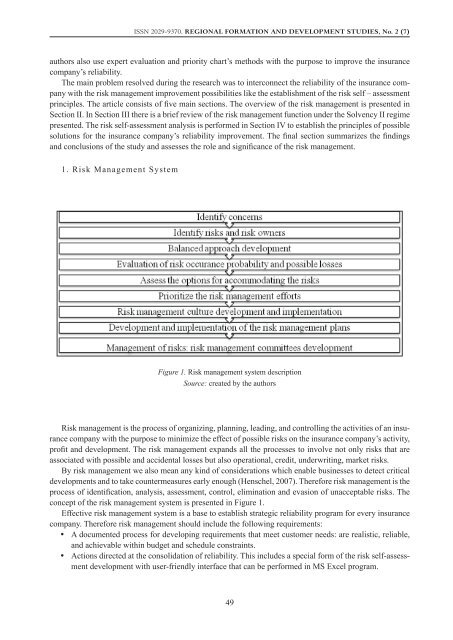regional formation and development studies - KlaipÄdos universitetas
regional formation and development studies - KlaipÄdos universitetas
regional formation and development studies - KlaipÄdos universitetas
Create successful ePaper yourself
Turn your PDF publications into a flip-book with our unique Google optimized e-Paper software.
ISSN 2029-9370. Regional Formation <strong>and</strong> Development Studies, No. 2 (7)<br />
authors also use expert evaluation <strong>and</strong> priority chart’s methods with the purpose to improve the insurance<br />
company’s reliability.<br />
The main problem resolved during the research was to interconnect the reliability of the insurance company<br />
with the risk management improvement possibilities like the establishment of the risk self – assessment<br />
principles. The article consists of five main sections. The overview of the risk management is presented in<br />
Section II. In Section III there is a brief review of the risk management function under the Solvency II regime<br />
presented. The risk self-assessment analysis is performed in Section IV to establish the principles of possible<br />
solutions for the insurance company’s reliability improvement. The final section summarizes the findings<br />
<strong>and</strong> conclusions of the study <strong>and</strong> assesses the role <strong>and</strong> significance of the risk management.<br />
1. Risk Management System<br />
Figure 1. Risk management system description<br />
Source: created by the authors<br />
Risk management is the process of organizing, planning, leading, <strong>and</strong> controlling the activities of an insurance<br />
company with the purpose to minimize the effect of possible risks on the insurance company’s activity,<br />
profit <strong>and</strong> <strong>development</strong>. The risk management exp<strong>and</strong>s all the processes to involve not only risks that are<br />
associated with possible <strong>and</strong> accidental losses but also operational, credit, underwriting, market risks.<br />
By risk management we also mean any kind of considerations which enable businesses to detect critical<br />
<strong>development</strong>s <strong>and</strong> to take countermeasures early enough (Henschel, 2007). Therefore risk management is the<br />
process of identification, analysis, assessment, control, elimination <strong>and</strong> evasion of unacceptable risks. The<br />
concept of the risk management system is presented in Figure 1.<br />
Effective risk management system is a base to establish strategic reliability program for every insurance<br />
company. Therefore risk management should include the following requirements:<br />
• y A documented process for developing requirements that meet customer needs: are realistic, reliable,<br />
<strong>and</strong> achievable within budget <strong>and</strong> schedule constraints.<br />
• y Actions directed at the consolidation of reliability. This includes a special form of the risk self-assessment<br />
<strong>development</strong> with user-friendly interface that can be performed in MS Excel program.<br />
49

















